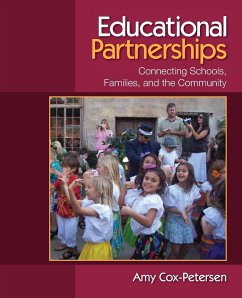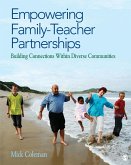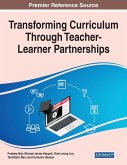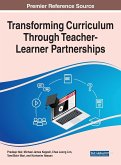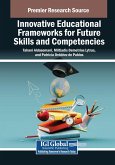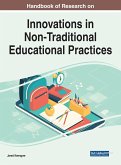- Broschiertes Buch
- Merkliste
- Auf die Merkliste
- Bewerten Bewerten
- Teilen
- Produkt teilen
- Produkterinnerung
- Produkterinnerung
This comprehensive text helps prepare pre-service and in-service teachers to build and sustain family, school, and community partnerships that are vital to student success. Focusing on grades preK-8, and with a particular emphasis on diverse families and learners, this book helps teachers to overcome barriers, create action plans, and sustain partnerships over time.
Andere Kunden interessierten sich auch für
![Empowering Family-Teacher Partnerships Empowering Family-Teacher Partnerships]() Mick ColemanEmpowering Family-Teacher Partnerships151,99 €
Mick ColemanEmpowering Family-Teacher Partnerships151,99 €![Global Trends and Issues in Educational Technology Global Trends and Issues in Educational Technology]() Dennis Relojo-HowellGlobal Trends and Issues in Educational Technology16,99 €
Dennis Relojo-HowellGlobal Trends and Issues in Educational Technology16,99 €![Transforming Curriculum Through Teacher-Learner Partnerships Transforming Curriculum Through Teacher-Learner Partnerships]() Transforming Curriculum Through Teacher-Learner Partnerships168,99 €
Transforming Curriculum Through Teacher-Learner Partnerships168,99 €![Transforming Curriculum Through Teacher-Learner Partnerships Transforming Curriculum Through Teacher-Learner Partnerships]() Transforming Curriculum Through Teacher-Learner Partnerships216,99 €
Transforming Curriculum Through Teacher-Learner Partnerships216,99 €![Innovative Educational Frameworks for Future Skills and Competencies Innovative Educational Frameworks for Future Skills and Competencies]() Innovative Educational Frameworks for Future Skills and Competencies218,99 €
Innovative Educational Frameworks for Future Skills and Competencies218,99 €![Innovative Educational Frameworks for Future Skills and Competencies Innovative Educational Frameworks for Future Skills and Competencies]() Innovative Educational Frameworks for Future Skills and Competencies165,99 €
Innovative Educational Frameworks for Future Skills and Competencies165,99 €![Handbook of Research on Innovations in Non-Traditional Educational Practices Handbook of Research on Innovations in Non-Traditional Educational Practices]() Handbook of Research on Innovations in Non-Traditional Educational Practices270,99 €
Handbook of Research on Innovations in Non-Traditional Educational Practices270,99 €-
-
-
This comprehensive text helps prepare pre-service and in-service teachers to build and sustain family, school, and community partnerships that are vital to student success. Focusing on grades preK-8, and with a particular emphasis on diverse families and learners, this book helps teachers to overcome barriers, create action plans, and sustain partnerships over time.
Hinweis: Dieser Artikel kann nur an eine deutsche Lieferadresse ausgeliefert werden.
Hinweis: Dieser Artikel kann nur an eine deutsche Lieferadresse ausgeliefert werden.
Produktdetails
- Produktdetails
- Verlag: Sage Publications, Inc
- Seitenzahl: 354
- Erscheinungstermin: 6. April 2010
- Englisch
- Abmessung: 235mm x 191mm x 19mm
- Gewicht: 661g
- ISBN-13: 9781412952125
- ISBN-10: 1412952123
- Artikelnr.: 28408127
- Herstellerkennzeichnung
- Libri GmbH
- Europaallee 1
- 36244 Bad Hersfeld
- gpsr@libri.de
- Verlag: Sage Publications, Inc
- Seitenzahl: 354
- Erscheinungstermin: 6. April 2010
- Englisch
- Abmessung: 235mm x 191mm x 19mm
- Gewicht: 661g
- ISBN-13: 9781412952125
- ISBN-10: 1412952123
- Artikelnr.: 28408127
- Herstellerkennzeichnung
- Libri GmbH
- Europaallee 1
- 36244 Bad Hersfeld
- gpsr@libri.de
Amy Cox-Petersen (Ph.D. [Curriculum and Instruction; Science Education Specialization] University of Southern California) is Professor in the Department of Elementary and Bilingual Education at California State University, Fullerton. Cox-Petersen received the Robert and Louise Lee Collaborative Award at Cal State Fullerton for her work with science professors across campus. She has written and received several grants related to service learning and collaborative partnerships with local schools and museums. Cox-Petersen has partnered with various organizations, schools, and interdisciplinary departments at Cal State Fullerton. As Science Education Specialist at the Natural History Museum of LA County, she helped to create partnerships within the educational community, with K-12 students and teachers, and with museum curators. As a public school teacher for 10 years, she collaborated with area businesses, universities, and parents. Cox-Petersen has published widely in leading education journals.
Preface
PART I: THE BASICS OF EDUCATIONAL PARTNERSHIPS
1. The Importance of Educational Partnerships
Overview of Educational Partnerships
Examples of Partnerships
The Value of Partnerships
Communities of Practice
Equitable Teaching and Learning
Types of Educational Partnerships
Collaborative Descriptions
Home, School, and Community Influences
Partnership Types, Examples, and Characteristics
Chapter Summary
Case Studies
Reflecting on the Cases
Activites for Further Development
Additional Reading and Information
2. History of Educational Partnerships
Goals of Education
Types of Schools
Students and Families as Part of a System
Social and Cultural Capital
History and Policy Related to Educational Partnerships
Educational Policy -Whose Policy? Who's Excluded?
Overview of Educational Learning Theories
Chapter Summary
Case Studies
Reflecting on the Cases
Activites for Further Development
Additional Reading and Information
3. Meeting the Needs of All Children in the 21st Century
The Implementation of No Child Left Behind
Children With Special Needs
Children's Well-Being
Nutrition and Children's Well-Being
Chapter Summary
Case Studies
Reflecting on the Cases
Activities for Further Development
Additional Reading and Information
4. The Makeup of Families Today: Culturally Relevant Strategies to Enhance
Partnerships
Families in the 21st Century
Family Participation Initiatives
A Culturally Responsive Partnership Between Home and School
Tips for Families and Teachers During: Parent-Teacher Conferences
Chapter Summary
Case Studies
Reflecting on the Cases
Activites for Further Development
Additional Reading and Information
PART II: BUILDING EFFECTIVE PARTNERSHIPS
5. Building Family-School Partnerships
Effective Partnerships With Families
Elements of Family-School Partnerships
Six Types of Family Involvement
Family Involvement in the 21st Century
Tips for Families and Teachers
Chapter Summary
Case Studies
Reflecting on the Cases
Activites for Further Development
Additional Reading and Information
6. Schools and Community: Working Together and Respecting Diversity
Expanding Educational Partnerships
School, Community, and Business Partnerships
Community Partnerships
Students Taking Action as Community Members
Tips for Building School-Community Partnerships
Chapter Summary
Case Studies
Reflecting on the Cases
Activites for Further Development
Additional Reading and Information
7. Partnering With Community Organizations and Resources
Partnerships Beyond the Four Walls of the Classroom
University-School Partnerships
Partnerships With Museums and Cultural Institutions
National/Local Parks and Outdoor Education
Tips for Organizing and Participating in Field Trips
Chapter Summary
Case Studies
Reflecting on the Cases
Activites for Further Development
Additional Reading and Information
8. Barriers to Partnerships
Culturally Relevant Teaching and Learning
Barriers and Challenges That Partnerships Face
Strategies to Address Barriers
Taking Action
Tips to Help Overcome Barriers and Promote Diversity
Chapter Summary
Case Studies
Reflecting on the Cases
Activities for Further Development
Additional Reading and Information
PART III: PLANNING FOR AND SUSTAINING SUCCESSFUL PARTNERSHIPS
9. Seeking and Sustaining Successful Partnerships
Partnership Examples
Seeking and Organizing Partnerships
Writing Grants That Support Teaching and Learning
Seeking Grants to Support and Acknowledge Teachers
Communicating With Families About Resources
Interagency Collaboration
Chapter Summary
Case Studies
Reflecting on the Cases
Activities for Further Development
Additional Reading and Information
10. Planning for Partnerships
Creating an Action Plan
Stages of the Planning Process
Implementing Your Action Plan
Chapter Summary
Case Studies
Reflecting on the Cases
Activites for Further Development
Additional Reading and Information
11. Implementing and Sustaining Successful Partnerships
Characteristics of Successful Partnerships Revisited
Parents, News, and Misconceptions
Professional Education Partnerships
Teachers as Reflective Practitioners
Implementing and Sustaining Educational Partnerships
Long-Running Partnership Examples
Local Libraries and Activities
Implementing and Sustaining Partnerships With Families
Tips for Implementing and Sustaining Partnerships
Final Comments
Activites for Further Development
Additional Reading and Information
Glossary
References
About the Author
Index
PART I: THE BASICS OF EDUCATIONAL PARTNERSHIPS
1. The Importance of Educational Partnerships
Overview of Educational Partnerships
Examples of Partnerships
The Value of Partnerships
Communities of Practice
Equitable Teaching and Learning
Types of Educational Partnerships
Collaborative Descriptions
Home, School, and Community Influences
Partnership Types, Examples, and Characteristics
Chapter Summary
Case Studies
Reflecting on the Cases
Activites for Further Development
Additional Reading and Information
2. History of Educational Partnerships
Goals of Education
Types of Schools
Students and Families as Part of a System
Social and Cultural Capital
History and Policy Related to Educational Partnerships
Educational Policy -Whose Policy? Who's Excluded?
Overview of Educational Learning Theories
Chapter Summary
Case Studies
Reflecting on the Cases
Activites for Further Development
Additional Reading and Information
3. Meeting the Needs of All Children in the 21st Century
The Implementation of No Child Left Behind
Children With Special Needs
Children's Well-Being
Nutrition and Children's Well-Being
Chapter Summary
Case Studies
Reflecting on the Cases
Activities for Further Development
Additional Reading and Information
4. The Makeup of Families Today: Culturally Relevant Strategies to Enhance
Partnerships
Families in the 21st Century
Family Participation Initiatives
A Culturally Responsive Partnership Between Home and School
Tips for Families and Teachers During: Parent-Teacher Conferences
Chapter Summary
Case Studies
Reflecting on the Cases
Activites for Further Development
Additional Reading and Information
PART II: BUILDING EFFECTIVE PARTNERSHIPS
5. Building Family-School Partnerships
Effective Partnerships With Families
Elements of Family-School Partnerships
Six Types of Family Involvement
Family Involvement in the 21st Century
Tips for Families and Teachers
Chapter Summary
Case Studies
Reflecting on the Cases
Activites for Further Development
Additional Reading and Information
6. Schools and Community: Working Together and Respecting Diversity
Expanding Educational Partnerships
School, Community, and Business Partnerships
Community Partnerships
Students Taking Action as Community Members
Tips for Building School-Community Partnerships
Chapter Summary
Case Studies
Reflecting on the Cases
Activites for Further Development
Additional Reading and Information
7. Partnering With Community Organizations and Resources
Partnerships Beyond the Four Walls of the Classroom
University-School Partnerships
Partnerships With Museums and Cultural Institutions
National/Local Parks and Outdoor Education
Tips for Organizing and Participating in Field Trips
Chapter Summary
Case Studies
Reflecting on the Cases
Activites for Further Development
Additional Reading and Information
8. Barriers to Partnerships
Culturally Relevant Teaching and Learning
Barriers and Challenges That Partnerships Face
Strategies to Address Barriers
Taking Action
Tips to Help Overcome Barriers and Promote Diversity
Chapter Summary
Case Studies
Reflecting on the Cases
Activities for Further Development
Additional Reading and Information
PART III: PLANNING FOR AND SUSTAINING SUCCESSFUL PARTNERSHIPS
9. Seeking and Sustaining Successful Partnerships
Partnership Examples
Seeking and Organizing Partnerships
Writing Grants That Support Teaching and Learning
Seeking Grants to Support and Acknowledge Teachers
Communicating With Families About Resources
Interagency Collaboration
Chapter Summary
Case Studies
Reflecting on the Cases
Activities for Further Development
Additional Reading and Information
10. Planning for Partnerships
Creating an Action Plan
Stages of the Planning Process
Implementing Your Action Plan
Chapter Summary
Case Studies
Reflecting on the Cases
Activites for Further Development
Additional Reading and Information
11. Implementing and Sustaining Successful Partnerships
Characteristics of Successful Partnerships Revisited
Parents, News, and Misconceptions
Professional Education Partnerships
Teachers as Reflective Practitioners
Implementing and Sustaining Educational Partnerships
Long-Running Partnership Examples
Local Libraries and Activities
Implementing and Sustaining Partnerships With Families
Tips for Implementing and Sustaining Partnerships
Final Comments
Activites for Further Development
Additional Reading and Information
Glossary
References
About the Author
Index
Preface
PART I: THE BASICS OF EDUCATIONAL PARTNERSHIPS
1. The Importance of Educational Partnerships
Overview of Educational Partnerships
Examples of Partnerships
The Value of Partnerships
Communities of Practice
Equitable Teaching and Learning
Types of Educational Partnerships
Collaborative Descriptions
Home, School, and Community Influences
Partnership Types, Examples, and Characteristics
Chapter Summary
Case Studies
Reflecting on the Cases
Activites for Further Development
Additional Reading and Information
2. History of Educational Partnerships
Goals of Education
Types of Schools
Students and Families as Part of a System
Social and Cultural Capital
History and Policy Related to Educational Partnerships
Educational Policy -Whose Policy? Who's Excluded?
Overview of Educational Learning Theories
Chapter Summary
Case Studies
Reflecting on the Cases
Activites for Further Development
Additional Reading and Information
3. Meeting the Needs of All Children in the 21st Century
The Implementation of No Child Left Behind
Children With Special Needs
Children's Well-Being
Nutrition and Children's Well-Being
Chapter Summary
Case Studies
Reflecting on the Cases
Activities for Further Development
Additional Reading and Information
4. The Makeup of Families Today: Culturally Relevant Strategies to Enhance
Partnerships
Families in the 21st Century
Family Participation Initiatives
A Culturally Responsive Partnership Between Home and School
Tips for Families and Teachers During: Parent-Teacher Conferences
Chapter Summary
Case Studies
Reflecting on the Cases
Activites for Further Development
Additional Reading and Information
PART II: BUILDING EFFECTIVE PARTNERSHIPS
5. Building Family-School Partnerships
Effective Partnerships With Families
Elements of Family-School Partnerships
Six Types of Family Involvement
Family Involvement in the 21st Century
Tips for Families and Teachers
Chapter Summary
Case Studies
Reflecting on the Cases
Activites for Further Development
Additional Reading and Information
6. Schools and Community: Working Together and Respecting Diversity
Expanding Educational Partnerships
School, Community, and Business Partnerships
Community Partnerships
Students Taking Action as Community Members
Tips for Building School-Community Partnerships
Chapter Summary
Case Studies
Reflecting on the Cases
Activites for Further Development
Additional Reading and Information
7. Partnering With Community Organizations and Resources
Partnerships Beyond the Four Walls of the Classroom
University-School Partnerships
Partnerships With Museums and Cultural Institutions
National/Local Parks and Outdoor Education
Tips for Organizing and Participating in Field Trips
Chapter Summary
Case Studies
Reflecting on the Cases
Activites for Further Development
Additional Reading and Information
8. Barriers to Partnerships
Culturally Relevant Teaching and Learning
Barriers and Challenges That Partnerships Face
Strategies to Address Barriers
Taking Action
Tips to Help Overcome Barriers and Promote Diversity
Chapter Summary
Case Studies
Reflecting on the Cases
Activities for Further Development
Additional Reading and Information
PART III: PLANNING FOR AND SUSTAINING SUCCESSFUL PARTNERSHIPS
9. Seeking and Sustaining Successful Partnerships
Partnership Examples
Seeking and Organizing Partnerships
Writing Grants That Support Teaching and Learning
Seeking Grants to Support and Acknowledge Teachers
Communicating With Families About Resources
Interagency Collaboration
Chapter Summary
Case Studies
Reflecting on the Cases
Activities for Further Development
Additional Reading and Information
10. Planning for Partnerships
Creating an Action Plan
Stages of the Planning Process
Implementing Your Action Plan
Chapter Summary
Case Studies
Reflecting on the Cases
Activites for Further Development
Additional Reading and Information
11. Implementing and Sustaining Successful Partnerships
Characteristics of Successful Partnerships Revisited
Parents, News, and Misconceptions
Professional Education Partnerships
Teachers as Reflective Practitioners
Implementing and Sustaining Educational Partnerships
Long-Running Partnership Examples
Local Libraries and Activities
Implementing and Sustaining Partnerships With Families
Tips for Implementing and Sustaining Partnerships
Final Comments
Activites for Further Development
Additional Reading and Information
Glossary
References
About the Author
Index
PART I: THE BASICS OF EDUCATIONAL PARTNERSHIPS
1. The Importance of Educational Partnerships
Overview of Educational Partnerships
Examples of Partnerships
The Value of Partnerships
Communities of Practice
Equitable Teaching and Learning
Types of Educational Partnerships
Collaborative Descriptions
Home, School, and Community Influences
Partnership Types, Examples, and Characteristics
Chapter Summary
Case Studies
Reflecting on the Cases
Activites for Further Development
Additional Reading and Information
2. History of Educational Partnerships
Goals of Education
Types of Schools
Students and Families as Part of a System
Social and Cultural Capital
History and Policy Related to Educational Partnerships
Educational Policy -Whose Policy? Who's Excluded?
Overview of Educational Learning Theories
Chapter Summary
Case Studies
Reflecting on the Cases
Activites for Further Development
Additional Reading and Information
3. Meeting the Needs of All Children in the 21st Century
The Implementation of No Child Left Behind
Children With Special Needs
Children's Well-Being
Nutrition and Children's Well-Being
Chapter Summary
Case Studies
Reflecting on the Cases
Activities for Further Development
Additional Reading and Information
4. The Makeup of Families Today: Culturally Relevant Strategies to Enhance
Partnerships
Families in the 21st Century
Family Participation Initiatives
A Culturally Responsive Partnership Between Home and School
Tips for Families and Teachers During: Parent-Teacher Conferences
Chapter Summary
Case Studies
Reflecting on the Cases
Activites for Further Development
Additional Reading and Information
PART II: BUILDING EFFECTIVE PARTNERSHIPS
5. Building Family-School Partnerships
Effective Partnerships With Families
Elements of Family-School Partnerships
Six Types of Family Involvement
Family Involvement in the 21st Century
Tips for Families and Teachers
Chapter Summary
Case Studies
Reflecting on the Cases
Activites for Further Development
Additional Reading and Information
6. Schools and Community: Working Together and Respecting Diversity
Expanding Educational Partnerships
School, Community, and Business Partnerships
Community Partnerships
Students Taking Action as Community Members
Tips for Building School-Community Partnerships
Chapter Summary
Case Studies
Reflecting on the Cases
Activites for Further Development
Additional Reading and Information
7. Partnering With Community Organizations and Resources
Partnerships Beyond the Four Walls of the Classroom
University-School Partnerships
Partnerships With Museums and Cultural Institutions
National/Local Parks and Outdoor Education
Tips for Organizing and Participating in Field Trips
Chapter Summary
Case Studies
Reflecting on the Cases
Activites for Further Development
Additional Reading and Information
8. Barriers to Partnerships
Culturally Relevant Teaching and Learning
Barriers and Challenges That Partnerships Face
Strategies to Address Barriers
Taking Action
Tips to Help Overcome Barriers and Promote Diversity
Chapter Summary
Case Studies
Reflecting on the Cases
Activities for Further Development
Additional Reading and Information
PART III: PLANNING FOR AND SUSTAINING SUCCESSFUL PARTNERSHIPS
9. Seeking and Sustaining Successful Partnerships
Partnership Examples
Seeking and Organizing Partnerships
Writing Grants That Support Teaching and Learning
Seeking Grants to Support and Acknowledge Teachers
Communicating With Families About Resources
Interagency Collaboration
Chapter Summary
Case Studies
Reflecting on the Cases
Activities for Further Development
Additional Reading and Information
10. Planning for Partnerships
Creating an Action Plan
Stages of the Planning Process
Implementing Your Action Plan
Chapter Summary
Case Studies
Reflecting on the Cases
Activites for Further Development
Additional Reading and Information
11. Implementing and Sustaining Successful Partnerships
Characteristics of Successful Partnerships Revisited
Parents, News, and Misconceptions
Professional Education Partnerships
Teachers as Reflective Practitioners
Implementing and Sustaining Educational Partnerships
Long-Running Partnership Examples
Local Libraries and Activities
Implementing and Sustaining Partnerships With Families
Tips for Implementing and Sustaining Partnerships
Final Comments
Activites for Further Development
Additional Reading and Information
Glossary
References
About the Author
Index

